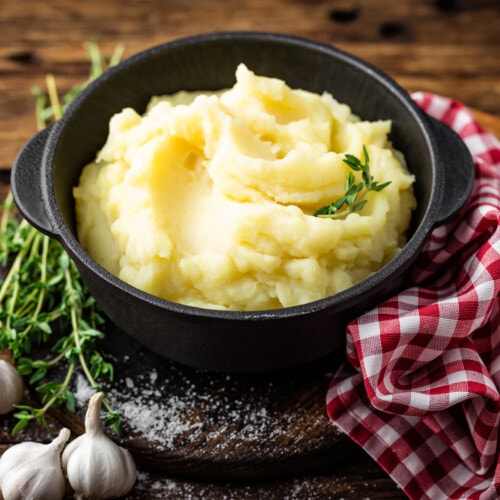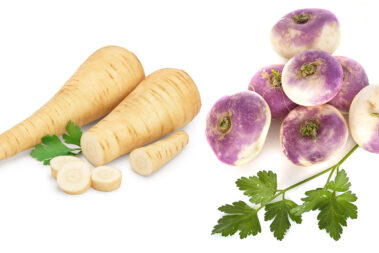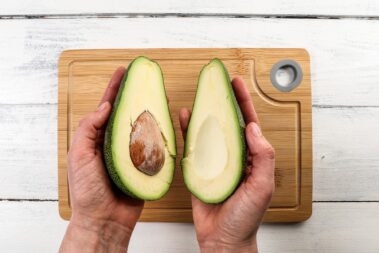Reheating mashed potatoes is one of the biggest challenges leftover eaters everywhere face. Luckily, there are some tried and true methods for this that deliver smooth, creamy potatoes without overdrying or turning them into glue.
So, what is the best way to reheat mashed potatoes? The best way to reheat mashed potatoes is to heat them covered in the oven at 350 degrees with extra milk and butter. Cook for 20 minutes or until warmed through.
But don’t worry if you don’t have the time or means to heat your leftover potatoes in the oven, because we’ve got four other ways that work almost just as well.
Table of Contents
5 Ways to Reheat Mashed Potatoes
Whether you’re pressed for time or looking to make the best dang reheated mashed potatoes possible, we’ve got a method that will work for you.
1. In the Oven
The oven method is the best choice for reheating mashed potatoes because you have very precise control over the temperature, which you don’t get on the stovetop. You also can keep the potatoes covered to retain moisture so they don’t dry out.
But to keep your potatoes from turning to glue, you’ll also need to add extra liquid and oil.
The addition of salt and fat to mashed potatoes helps prevent the starches in them from absorbing too much water. When these starches can’t take in too much water, they can’t rupture, which means they won’t turn to glue, even under high temperatures. For this reason, you should always add extra butter or oil and some sodium to your leftover mashed potatoes before heating.
Adding additional liquid, such as milk, plant-based milk, or vegetable broth can also help by keeping the potatoes from drying out.
To reheat mashed potatoes in the oven:
- Place your leftover mashed potatoes in an oven-safe dish.
- Stir in melted butter, melted vegan butter, or oil and milk/cream, vegan milk, or broth. Start with about 1/2c liquid for every 4 cups of potatoes. Your final product should be smooth but not runny.
- Cover the dish with a lid or foil and place in an oven preheated to 350 degrees.
- Cook for 20 to 30 minutes or until heated through (at least 165 degrees).
This method allows your potatoes to heat gradually while retaining moisture and avoiding gelatinization. It takes a little longer than other methods, but produces the most consistent results.
You can use this same basic method to cook mashed potatoes you’ve made ahead of time. But instead of adding the extra liquid before popping them in the oven, cook for half the time then check and only add more butter and milk if they seem to be drying out. Add only as much extra liquid as needed, then continue cooking until heated through.
2. In the Slow Cooker
Another great method for reheating mashed potatoes is in the slow cooker.
Like the oven, the slow cooker allows the potatoes to retain moisture and to heat gradually. You don’t have quite as much control over the temperature. But as long as you’re patient, it is difficult to overheat potatoes this way.
To reheat mashed potatoes in a slow cooker:
- Coat the slow cooker insert with butter, vegan butter, or oil.
- Add a small amount of liquid (cream/milk, vegan milk, or broth) to the bottom of the pot.
- Stir butter, vegan butter, or oil and milk/cream, vegan milk, or broth into your mashed potatoes before adding them to the pot. Start with about 1/2c liquid for every 4 cups of potatoes. Your final product should be smooth but not runny.
- Add the potatoes to the slow cooker, cover, and cook on low until the potatoes are heated through. Continue to warm in the pot for up to 4 hours.
This method takes the longest but works very well if you have premade your mashed potatoes to serve alongside a larger meal.
If you have a lot of food prep to do for Thanksgiving dinner, for instance, making your potatoes up to two days ahead and cooking them this way is a great way to reduce your workload and save oven space. If you’ve already added your liquid and oil to the uncooked mashed potatoes, don’t add more before putting them in the crockpot. Instead, check on them occasionally and only add extra milk and butter if they seem to be drying out.
3. In a Double Boiler
Using a double boiler allows you to reheat mashed potatoes relatively quickly without risking drying them out. If you don’t have a true double boiler, you can DIY your own by placing a heat-proof glass bowl on top of a pot filled with water.
Just make sure the top edge of the bowl is wide enough to sit above the boiling water and that you have a lid that fits tightly over it.
To reheat mashed potatoes in a double boiler:
- Add the mashed potatoes to the top of the double boiler or to your glass bowl.
- Stir in melted butter, melted vegan butter, or oil and milk/cream, vegan milk, or broth. Start with about 1/2c liquid for every 4 cups of potatoes. Your final product should be smooth but not runny.
- Fill the bottom pot with water. Make sure the water is below the bottom of the top bowl.
- Boil the water with the lid secured over the potatoes. Stir frequently but not vigorously until the potatoes are heated through.
This method is quicker than the previous two but runs a higher risk of overheating the mashed potatoes, especially if you are not stirring frequently enough. However, the added moisture and indirect heat from the boiling water will help prevent the potatoes from drying out.
4. In the Microwave
The microwave method is by far the quickest method for reheating mashed potatoes, but it is also the trickiest method to get right. Too much heat and you’ll dry your potatoes out. Too much moisture and they’ll turn to glue.
The directions below, which are similar to reheating stuffing in the microwave, work well in most situations. But they will need to be adapted based on your microwave power and how much mashed potatoes you’re reheating at once.
To reheat mashed potatoes in the microwave:
- Place your potatoes in a microwave-safe bowl.
- Stir in melted butter, melted vegan butter, or oil and milk/cream, vegan milk, or broth. Start with about 1/2c liquid for every 4 cups of potatoes. Your final product should be smooth but not runny.
- Cover and microwave on 50% power for 1 minute.
- Stir gently and place back in the microwave for another minute.
- Continue stirring and heating like this until the potatoes are heated through.
If you notice your potatoes getting too dry, add more liquid. If they are getting gummy, turn the power down even more and stir less frequently.
The microwave can also be used to cook mashed potatoes that you’ve made ahead of time. For these, follow the same heating instructions, but only add extra milk and butter if the potatoes appear to be drying out before getting heated all the way through.
5. On the Stove
My least favorite method for reheating mashed potatoes is on the stovetop. But, it can work in a pinch if you’re careful.
The trick is to heat slowly, add liquid, and stir enough but not too much.
What kind of liquid to add is really up to you. Water works well if you don’t want to change the flavor of the mashed potatoes. Adding heavy cream or milk also works. Whatever liquid you choose, I do recommend adding a tablespoon of butter, as well, to keep the potatoes from burning on the bottom.
To reheat mashed potatoes on the stove:
- Place your leftover potatoes in a saucepan (they are easier to stir in a low-sided pan than they are in a pot).
- Add a tablespoon or two of liquid plus some butter.
- Set the burner to low heat and put a lid on the pan.
- Stir occasionally. If you stir too often or too vigorously, you’ll end up with a gluey texture.
- Add more liquid as needed.
Once the potatoes are warmed through, they’re ready to enjoy with your favorite vegan gravy, plant-based turkey, or a heaping of vegan cheddar and chives.
Expert Tip: Reheat While Balancing Moisture and Heat
The reason mashed potatoes are so difficult to reheat has to do with their starch content. The amylose starch in potatoes reacts one of two ways when heated.
If exposed to dry heat, these starches turn brown and break down into sugar. This is what you see happening along the outer edges of a baked potato. This sweet crunchiness is great for campfire spuds, but not so desirable in mashed potatoes.
If exposed to moist heat, these starches absorb water, swell, and become viscous. The right amount of heat gives you smooth, creamy potatoes. But too much heat causes the starches to burst, and the potatoes to become gelatinous and gluey.
Fighting these two potential outcomes is difficult when you make fresh mashed potatoes, but it’s even more difficult when reheating leftovers. The four methods above were designed to keep your leftover potatoes moist while they reheat without allowing them to overheat.
Alternative: Make-Ahead Mashed Potatoes
One reason many people end up reheating their mashed potatoes is that they don’t have time to cook them the day they want to eat them. If you’re in the midst of holiday dinner chaos, then you know exactly what I’m talking about.
Luckily, making mashed potatoes ahead of time is fairly straightforward.
Potatoes that haven’t been heated up before are much less likely to dry out. But they can still get gummy, especially when going from the cold fridge straight into the hot oven. The way to overcome this challenge is to heap on a little extra fat upfront to stabilize the starches even more.
To make your mashed potatoes ahead of time:
- Boil 4 pounds of potatoes until tender (Yukon gold or russets work best).
- Mash the potatoes as you normally would and add any seasoning you desire (herbs, garlic, salt and pepper, etc.).
- Then carefully fold in 8 ounces of softened cream cheese (vegan cream cheese will also work, just make sure it is full-fat, not a light variety).
- Fold in 2 tbsp of softened butter (or vegan butter) and ½ cup thick plain yogurt (or Greek-style vegan yogurt).
- Press the mashed potatoes into an oven-safe baking dish, cover, and refrigerate for up to two days.
- When you are ready to heat, take the dish out of the fridge and let it sit for 1 hour.
- Then bake at 350 degrees for 30 to 40 minutes until heated through.
By adding extra fat in the form of cream cheese and substituting yogurt for liquidy milk, you’ll assure your potatoes stay moist without getting too watery or turning to glue.
FAQ
How do you store leftover mashed potatoes?
The best way to store leftover mashed potatoes is in an oven-safe dish with a tight-fitting lid placed in the fridge. This way, when you are ready to reheat your potatoes, you only have to stir in your extra oil and liquid and pop them in the oven. If you plan to reheat a small amount at a time, portion the mashed potatoes out into individual servings and store them in airtight containers in the fridge.
How long are leftover mashed potatoes good for?
Like most leftovers, mashed potatoes are good for around 3 to 5 days when stored in an airtight container in the fridge. Potatoes without dairy ingredients may last slightly longer. When reheating your mashed potatoes, be sure to get the internal temperature up to 165 degrees before enjoying.
Can I make mashed potatoes and reheat the next day?
You absolutely can make mashed potatoes ahead of time to reheat them the following day. If you go this route, I highly recommend following our “make ahead” mashed potatoes recipe above. It reheats much better than traditional mashed potato recipes.
Don’t Forget the Gravy!
You can’t enjoy reheated mashed potatoes without a ladle of gravy over the top. If you follow a vegan diet, I recommend trying this awesome mushroom gravy for all the salty, savory complexity of the real thing without the animal products.
Or if you want to mix up your topping game, check out our picks for the best vegan cheese brands and our recipe for vegan sour cream.
And if you’re a big fan of making mashed potatoes, you may want to check out our picks for the best potato ricers. These tools make mashing potatoes so much easier while producing a smoother product.
Lastly, if you like these vegan recipe recommendations, don’t forget to sign up for our newsletter. You’ll receive emails with our newest content and extra vegan tips and tricks.
Reheating Mashed Potatoes Made Simple
While reheating mashed potatoes is best done in the oven, the microwave, stovetop, double broiler, or crockpot can work just as well. The trick is balancing heat and moisture to keep your potatoes from breaking down into sugar or swelling and becoming gluey.
What is your favorite method for reheating leftovers like mashed potatoes? Let us know by posting in the comments section below!

The Best Way to Reheat Mashed Potatoes
Ingredients
- 1 batch leftover mashed potatoes
Instructions
- Place leftover mashed potatoes in an oven-safe dish.
- Stir in melted butter, melted vegan butter, or oil and milk/cream, vegan milk, or broth. Start with about 1/2c liquid for every 4 cups of potatoes. Your final product should be smooth but not runny.
- Cover the dish with a lid or foil and place in an oven preheated to 350 degrees.
- Cook for 20 to 30 minutes or until heated through (at least 165 degrees).
- How to Pick the Perfect Watermelon For a Sweet Summer Treat - April 10, 2024
- Future Kind’s Foundations: A Multivitamin Made for Vegans - December 5, 2023
- Does Nutritional Yeast Go Bad? - November 28, 2023








